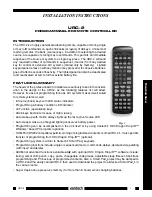
9
BEFORE USE
Before making any adjustments, learn the operation of the transmitter and the move-
ment of each servo.
CHANNEL 1
RUDDER OPERATION
When the rudder stick is moved to the right, the rudder moves to the right and
the nose points to the right, relative to the direction of flight. When the rudder
stick is moved to the left, the rudder moves to the left and the nose points to
the left and the direction of travel of the plane changes.
AILERON OPERATION
When the aileron stick is moved to the right, the right aileron is raised and the
left aileron is lowered, relative to the direction of flight, and the plane turns to
the right. When the aileron stick is moved to the left, the ailerons move in the
opposite direction.
To level the plane, the aileron stick must be moved in the opposite direction.
When the aileron stick is tilted and held, the plane will roll.
CHANNEL 2
ELEVATOR OPERATION
When the elevator stick is pulled back, the tail elevator is raised and the tail of
the plane is forced down, the air flow applied to the wings is changed, the
lifting force is increased, and the plane climbs (UP operation). When the
elevator stick is pushed forward, the elevator is lowered, the tail of the plane is
forced up, the air flow applied to the wings is changed, the lifting force is
decreased, and the plane dives (DOWN operation).
CHANNEL 3 (only T3FR)
THROTTLE/FLAP/SPOILER OPERATION
The channel 3 can be used for engine control, electronic speed control, flap, or
spoilers.
When the throttle lever is pulled back (low side), the motor is stopped. When
the throttle lever is pushed forward (high side), the motor turns.
Adaptation for some speed controls so that the direction of
operation is opposite (i.e. MC114, MC117):
•Request the adaptation to the Futaba Service Center.
T
RANSMITTER
O
PERATION
AND
M
OVEMENT
OF
E
ACH
S
ERVO
Right Aileron
Up Elevator
ELEVON OPERATION
Up Elevator
Right Rudder
V-TAIL OPERATION
(view from rear)
MIXING OPERATION
(when MIX function is turned on)
This mixing is used with V-tail aircraft, delta wings, etc. so that both
channel 1 and channel 2 functions are combined for the two surfaces.




































